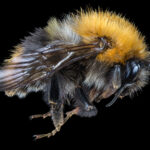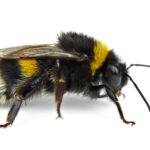How Can We Help?
What is the difference between honey bees and bumble bees?
Honey bees and bumble bees, both essential pollinators, exhibit notable differences in appearance, behavior, and habitat. Honey bees are smaller, with slender bodies measuring about 0.5 to 0.6 inches in length. They feature smooth, hairless abdomens adorned with pale yellow and brown bands. In contrast, bumble bees are larger, ranging from 0.6 to 1 inch, with robust, fuzzy bodies covered in dense hair and distinct black and yellow stripes.
 Behavior-wise, honey bees are highly social, residing in large, complex colonies that can house thousands of individuals. They construct intricate hives, often within man-made structures, where they produce and store honey. Bumble bees also live in colonies, but these are smaller, typically comprising a few hundred bees. They usually nest in the ground or dense vegetation, often repurposing old rodent burrows.
Behavior-wise, honey bees are highly social, residing in large, complex colonies that can house thousands of individuals. They construct intricate hives, often within man-made structures, where they produce and store honey. Bumble bees also live in colonies, but these are smaller, typically comprising a few hundred bees. They usually nest in the ground or dense vegetation, often repurposing old rodent burrows.
When it comes to pollination, honey bees are generalists, visiting a wide variety of flowers. Bumble bees, however, can forage in cooler, wetter conditions and excel at pollinating specific crops through a process called buzz pollination. Honey bees tend to be more aggressive in defending their hives, whereas bumble bees are generally more docile.
Understanding these differences is important for effective conservation and management practices, ensuring both species continue to thrive and support biodiversity and agriculture.
Where do bumble bees build their hives?
Bumble bees build their hives in a variety of hidden spots, usually close to the ground. Unlike honey bees that create elaborate hives, bumble bees prefer more natural, sheltered spaces. They often nest in abandoned rodent burrows, dense grass tussocks, compost piles, and under garden sheds. They might also use cavities in logs, under rocks, or in thick vegetation. The nests are usually insulated with grass, moss, or leaves, which the queen gathers to make a comfy environment for her colony.
A bumble bee nest generally hosts a few hundred bees, much smaller than a honey bee hive. Inside, bumble bees
Bumble bee nests are typically annual, with the colony dying off in late autumn, except for new queens who hibernate and reappear in spring to start new colonies. Understanding how bumble bees nest is crucial for their conservation, as habitat loss and environmental changes can greatly affect their populations. Our team here at Youngs Pest Control is dedicated to protecting and preserving these important pollinators, so don't hesitate to contact us for any bumble bee-related concerns.
